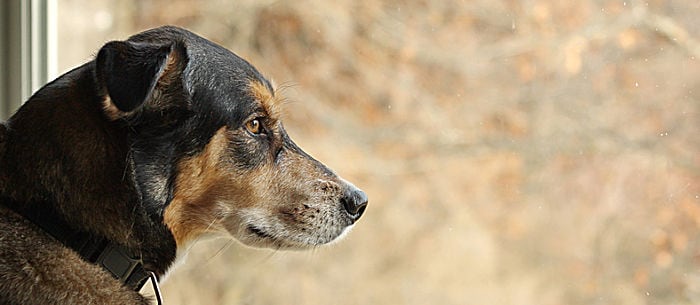Does your dog whine whenever you leave her home alone? Do you often come back to find traces of destruction? If so, your furry friend might be suffering from separation anxiety, which can be hard on both you and your pet. Thankfully, there is a variety of things you can do to ease your dog’s anxiety and avoid feeling guilty every time you need to run out to get some groceries.
Here’s an overview on dog separation anxiety.
What Is Dog Separation Anxiety and What Triggers It?
Separation anxiety is a condition in which your dog becomes very anxious and displays behavioral changes when he is left alone. As is the case with humans, your dog’s anxiety is chemically based, says Ailigh Vanderbush, a certified dog trainer. Certain types of events can trigger these feelings of fear and nervousness.
For instance, your dog may experience separation anxiety if you have moved or changed his schedule in some way. Other potential triggers are the loss of a family member, changes in guardianship and traumatic events. But it’s important to remember that seemingly minor events and changes can seem traumatic from your dog’s point of view. For instance, your dog may experience separation anxiety if you board him when you go out of town or if your teenager has left the nest and gone off to college.
What Are the Symptoms of Separation Anxiety in Dogs?
Many behaviors may indicate that your dog has separation anxiety. For instance, dogs that suffer from this condition “will often hurt themselves, damage their teeth, ingest anything in their crate, urinate and defecate and experience excessive drooling,” says Vanderbush. If your dog has separation anxiety, she may drool and appear nervous when you prepare to leave the house.
Then, when she is left alone, she may dig at floors, scratch doors and attempt to escape from your house or her crate. She will also likely whine, howl or bark persistently when she is separated from you. When you return, you may find her pacing and chewing excessively. Furthermore, you pet may only relieve herself when she is alone.
How Should You Leave and Enter Your Home?
If your pet is suffering from separation anxiety, Vanderbush advises that you seek out the help of both a veterinarian and a behavioral specialist. There is a variety of behavior modification techniques that you should put into place, but your vet may prescribe medication, as well.
According to Vanderbush, you can start easing and preventing your dog’s anxiety symptoms by making a variety of changes to your own behavior. “How you leave and enter your home affects the dog,” she says. “You don’t want to make leaving or coming home a big deal.” Vanderbush urges you to avoid making your leaving predictable for your pet. For instance, don’t grab your keys and put your coat until right before you leave. “The dog learns these are cues that mean imminent departure.”
When you do need to leave your pup, you should use counter conditioning to replace some of his fear with excitement for a special treat, like a toy stuffed with peanut butter. You can also try leaving an unwashed piece of clothing for your dog, as the scent will provide some comfort for him.
“An independent thinker with an enriched environment won’t fall apart when left alone,” says Vanderbush. As such, it’s important that you strive to make your pet as independent as possible. You can also help to prevent his anxiety by making sure that he has enough exercise and enrichment. Furthermore, you can build up your pet’s trust by making very short trips out so that he knows you’ll come back home. Most of your dog’s separation anxiety will begin within the first 40 minutes of you leaving.
And when you do return home, you should avoid exciting your pet. For instance, you should not talk or pay attention to him right away. Instead, you should calmly greet him after a few minutes and take him outside as normal.
What Should You Avoid Doing?
According to Vanderbush, you should avoid getting angry and punishing your dog, as this will not help the situation at all. And, while you might be tempted to get another pet to keep your dog company, this will not have an effect on his separation anxiety. His feelings of nervousness stem from issues he has with you leaving and the introduction of this new family member will not alleviate those feelings.
Crate training helps some dogs conquer their separation anxiety because they see their crate as a safe den. If your dog isn’t crate trained, introducing one into the equation may also make matters worse because your dog might try to escape and injure himself in the process.
If you want to see if crate training works for your pet, Vanderbush advises that you practice crate time while you are home, instead of only using the crate when you are leaving. If your dog cries, whines, drools or exhibits other anxiety symptoms while in a crate, you should consider confining her to a room instead.
For more information on crate training, check out Crate Training for Your Dog: Good or Bad?
Kit Arbuckle works as a freelance writer covering parenting, education, health and pet care topics.
*This article is for general informational purposes only. It is not intended nor implied to be providing medical advice and is not a substitute for such advice. The reader should always consult a health care provider concerning any medical condition or treatment plan. Neither Care.com nor the author assumes any responsibility or liability with respect to use of any information contained herein.

